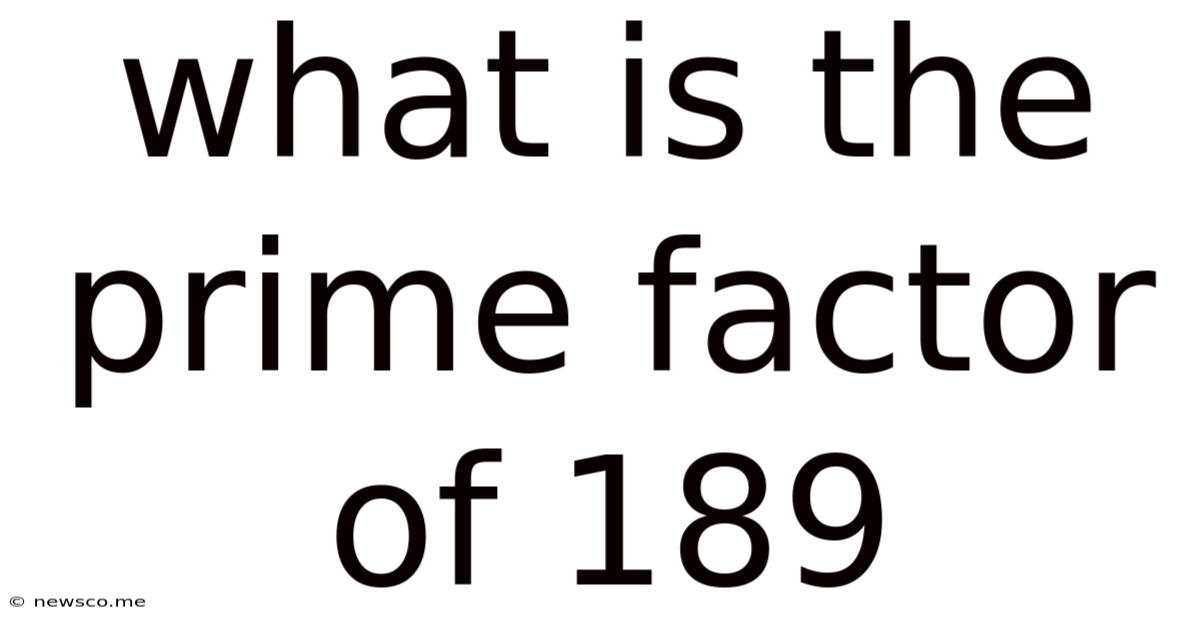What Is The Prime Factor Of 189
News Co
Mar 21, 2025 · 5 min read

Table of Contents
What is the Prime Factor of 189? A Deep Dive into Prime Factorization
Finding the prime factors of a number might seem like a simple mathematical exercise, but understanding the process reveals fundamental concepts in number theory and has practical applications in various fields. This article will thoroughly explore the prime factorization of 189, explaining the method, providing examples, and discussing the significance of prime numbers in mathematics and beyond.
Understanding Prime Numbers and Prime Factorization
Before diving into the prime factorization of 189, let's refresh our understanding of key terms:
Prime Number: A prime number is a whole number greater than 1 that has only two divisors: 1 and itself. Examples include 2, 3, 5, 7, 11, and so on. A number that is not prime is called a composite number.
Prime Factorization: Prime factorization (or integer factorization) is the process of finding the prime numbers that, when multiplied together, equal the original number. Every composite number can be expressed as a unique product of prime numbers. This is known as the Fundamental Theorem of Arithmetic.
Finding the Prime Factors of 189: A Step-by-Step Approach
To find the prime factors of 189, we'll use a method called the factor tree. This method involves repeatedly dividing the number by its smallest prime factor until we're left with only prime numbers.
-
Start with the number 189: We begin with our target number, 189.
-
Find the smallest prime factor: The smallest prime number is 2. However, 189 is an odd number, so it's not divisible by 2. The next prime number is 3. 189 divided by 3 is 63.
-
Continue the process: Now we consider 63. 63 is also divisible by 3, resulting in 21.
-
Repeat until all factors are prime: We continue with 21. 21 is divisible by 3, giving us 7.
-
The prime factors: We've reached 7, which is a prime number. Therefore, the prime factorization of 189 is 3 x 3 x 3 x 7, or 3³ x 7.
Therefore, the prime factors of 189 are 3 and 7. 3 appears three times (3 cubed).
Visualizing Prime Factorization with a Factor Tree
A factor tree provides a visual representation of the prime factorization process:
189
/ \
3 63
/ \
3 21
/ \
3 7
This tree clearly shows how we break down 189 into its prime factors: 3, 3, 3, and 7.
Alternative Methods for Finding Prime Factors
While the factor tree method is intuitive and visually appealing, other methods can also be used:
-
Division Method: This method involves systematically dividing the number by prime numbers starting from the smallest (2, 3, 5, 7, and so on) until only 1 remains. The prime numbers used in the divisions are the prime factors.
-
Using a Prime Factorization Calculator: Several online calculators and software programs can automatically determine the prime factorization of a number. These tools can be particularly helpful for very large numbers.
The Significance of Prime Factorization
Prime factorization might seem like a purely mathematical exercise, but it has significant implications in several areas:
-
Cryptography: The security of many modern encryption systems relies on the difficulty of factoring large numbers into their prime factors. The RSA algorithm, for instance, uses this principle. Breaking these codes requires incredibly powerful computers and sophisticated algorithms.
-
Number Theory: Prime numbers are fundamental building blocks in number theory, a branch of mathematics dedicated to the study of integers. Many theorems and conjectures in number theory revolve around the properties of prime numbers, including their distribution and relationships.
-
Computer Science: Prime factorization algorithms are used in various computer science applications, including hashing, random number generation, and data compression.
-
Coding Theory: Prime numbers play a crucial role in coding theory, which deals with designing efficient and reliable methods for transmitting data.
-
Abstract Algebra: Prime factorization forms the basis for understanding ideals in ring theory, a branch of abstract algebra.
Beyond 189: Exploring Prime Factorization of Other Numbers
Let's illustrate the prime factorization process with a few more examples:
Example 1: Prime factorization of 72
72 = 2 x 36 = 2 x 2 x 18 = 2 x 2 x 2 x 9 = 2 x 2 x 2 x 3 x 3 = 2³ x 3²
Example 2: Prime factorization of 255
255 = 3 x 85 = 3 x 5 x 17
Example 3: Prime factorization of 1000
1000 = 10 x 100 = 10 x 10 x 10 = 2 x 5 x 2 x 5 x 2 x 5 = 2³ x 5³
These examples demonstrate the consistent application of the method across different numbers. Regardless of the complexity, the fundamental principle remains the same: repeatedly divide by the smallest prime factor until only prime numbers remain.
Conclusion: The Enduring Importance of Prime Factors
The prime factorization of 189, as we've seen, is 3³ x 7. This seemingly simple calculation reveals a fundamental aspect of number theory and highlights the importance of prime numbers in mathematics and beyond. Understanding prime factorization is not merely an academic pursuit; it underpins crucial concepts in cryptography, computer science, and other fields. By mastering this fundamental concept, we gain a deeper appreciation for the elegance and power of prime numbers and their far-reaching applications in our world. The process, while seemingly simple, opens doors to complex and fascinating mathematical landscapes. Further exploration of prime numbers and their properties can lead to a deeper understanding of the building blocks of mathematics itself.
Latest Posts
Related Post
Thank you for visiting our website which covers about What Is The Prime Factor Of 189 . We hope the information provided has been useful to you. Feel free to contact us if you have any questions or need further assistance. See you next time and don't miss to bookmark.